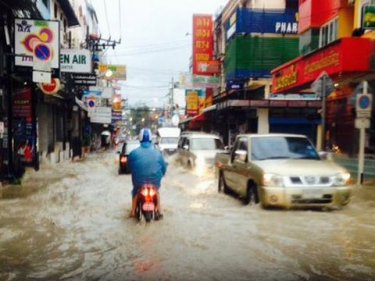With the rain forecast to keep falling, authorities called in a crane to deal with the fallen power poles outside the Merlin Beach Resort at Tritrang, south of Patong.
For the first time, officials in Patong sense they have a weapon to quickly combat floods in Patong: Mobile pumps that appeared to be working quite successfully today in clearing the streets.
''Heavier rain might be more difficult to clear but we're now confident we have a way of combatting Patong floods,'' an official told Phuketwan.
In Phuket City, authorities blamed a ditch that is part of construction work on a new resort going up in the bypass road for flooding that caused traffic congestion.
They also are looking at using more pumps to make sure the underpass under construction at the Tesco Lotus intersection stays drier than the roads above it, which seem to be flooded with each downpour.
Rain is forecast to fall all day today - and keep falling over Phuket for the rest of the week, according to forecasters. Everybody may need their own water pump.
Electricity authorities were rectifying problems caused by the branch of a tree toppling two power poles outside the resort, south of Patong, and confident the problem would be resolved shortly.










Always reactive. As if the annual rains come as a total surprise.
Posted by Herbert on June 16, 2015 12:51